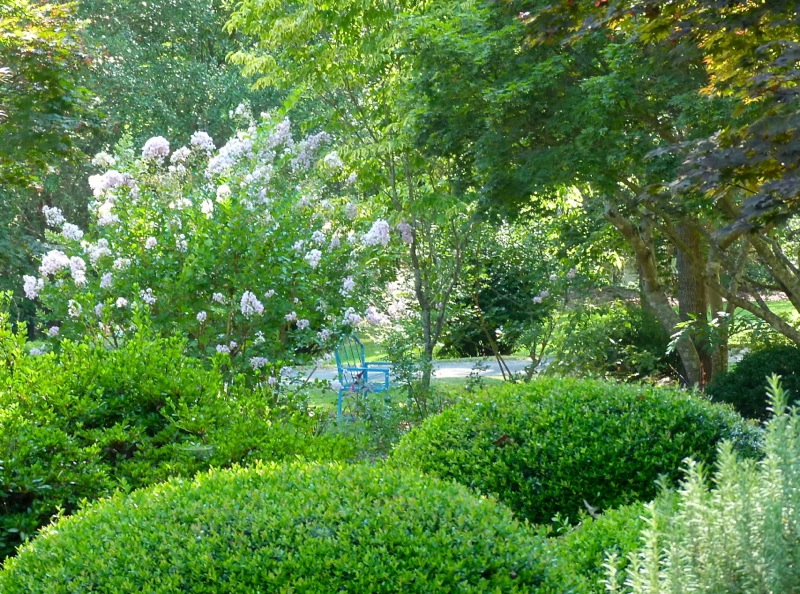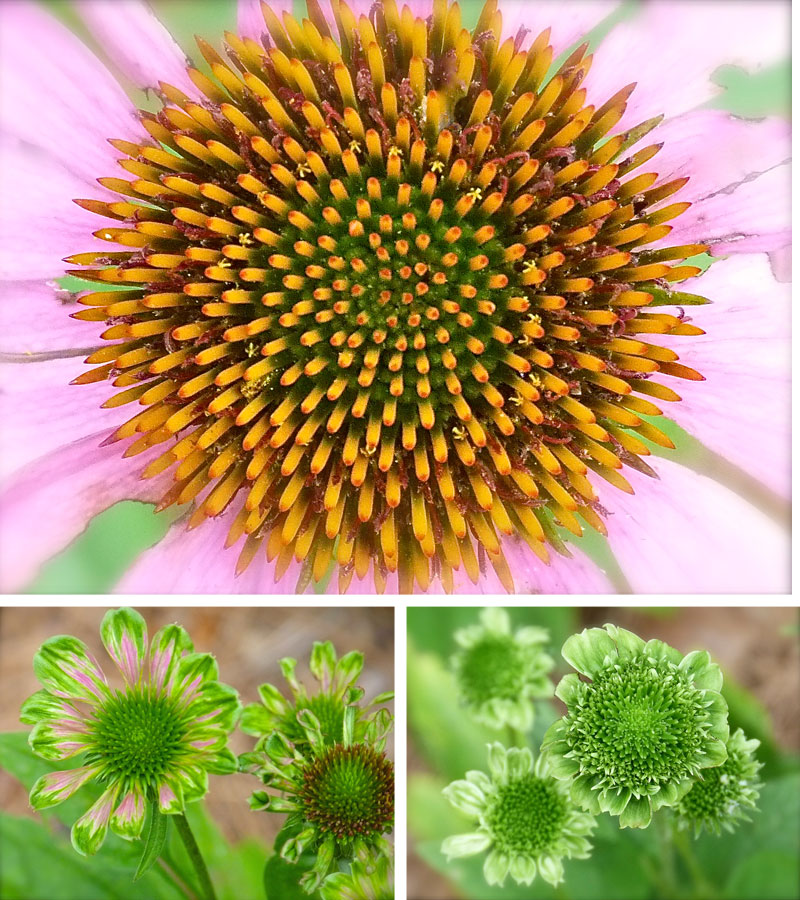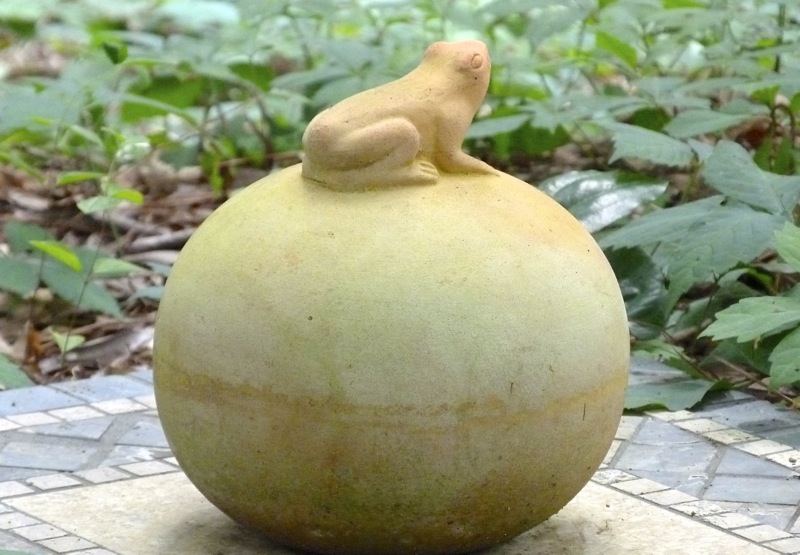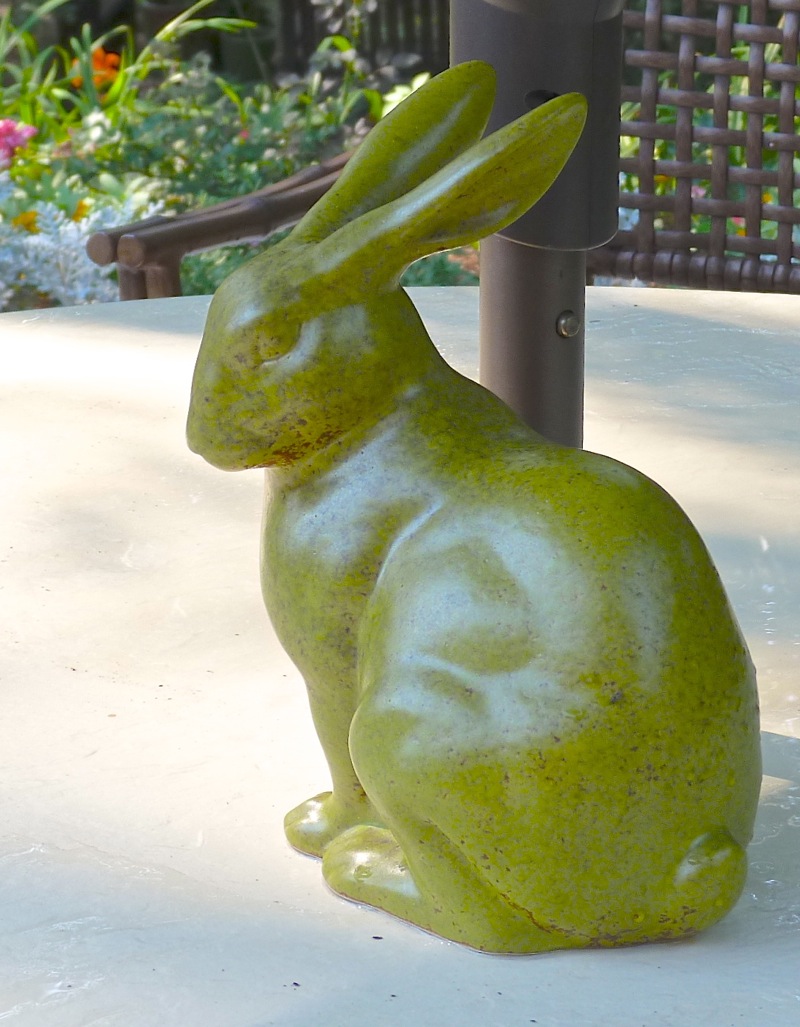My Kind of Summer
 Sunday, July 6, 2014 at 5:00AM
Sunday, July 6, 2014 at 5:00AM High summer is here with steamy viscous air so thick one can barely breathe...except, that was not true for the last couple of days. We have had a reprieve. A short one, for traditional weather is returning quickly. But July 4th and 5th have been more like spring days, with lower humidity and exhilarating breezes to mitigate the warm temperatures, which only made it into the eighties. At night, we can open our windows! I enjoyed this unexpected gift by spending extra time in the garden. A recent close-up of one of my Snowflake hydrangeas. Snowflake hydrangeas have double blooms, unlike common Oakleaf hydrangeas, and as they age, they turn dusty rose. Oakleaf hydrangeas are native and offer year-round beauty and interest.A month ago, when I posted on the June garden, this same view of the front garden, shown below, was a swath of pink, but now the Knockout roses are quiet, getting ready to produce another flush, and the Anthony Waterer spireas are putting out only occasional blooms. Soon I will trim them back.
A recent close-up of one of my Snowflake hydrangeas. Snowflake hydrangeas have double blooms, unlike common Oakleaf hydrangeas, and as they age, they turn dusty rose. Oakleaf hydrangeas are native and offer year-round beauty and interest.A month ago, when I posted on the June garden, this same view of the front garden, shown below, was a swath of pink, but now the Knockout roses are quiet, getting ready to produce another flush, and the Anthony Waterer spireas are putting out only occasional blooms. Soon I will trim them back.

The crepe myrtles are blooming and will provide color for the rest of the summer. In the front garden there are two old-fashioned watermelon-pink ones and three lavender "miniatures." From this photo you can see how large "miniature" is, though advertised to grow to three feet!
Here is one image from the woodland garden, taken late afternoon as the sun was streaming through. This is my favorite time to be in the woodland garden; it is magical! The fern in the foreground is a Bird's Nest fern, Asplinium nidus. It is in a pot so I can bring it in for the winter.
High summer in the Deep South means green in all its manifestations. Foliage reigns supreme. Here is a sampling from my garden: Clockwise from top left: Indigofera ground cover; Crookneck squash leaf; Rhododendron, which has never bloomed, but maybe someday; Native holly fern; Variegated sedge; Maidenhair fern.
Clockwise from top left: Indigofera ground cover; Crookneck squash leaf; Rhododendron, which has never bloomed, but maybe someday; Native holly fern; Variegated sedge; Maidenhair fern.
 Clockwise from top left: Pilea; Hydrangea 'Lady in Red'; Japanese Painted Fern; Anise 'Florida Sunshine'; Variegated Jacob's Ladder; Native Trillium cuneatum and Autumn fern.
Clockwise from top left: Pilea; Hydrangea 'Lady in Red'; Japanese Painted Fern; Anise 'Florida Sunshine'; Variegated Jacob's Ladder; Native Trillium cuneatum and Autumn fern.
Foliage may be supreme, but flowers continue to play a lovely part in the garden. Coneflowers are doing well, or maybe they are not. Some of them have flowers that appear stunted. Those all-green things...do they have a virus, or am I lucky to have a weird new variety?
Here are more flowers. At the top are the very last of my foxgloves. The beauty of the fading leaves, their veins prominently outlined in pink, caught my attention. Almost, one would think they were supposed to be that way! Top: Fading Foxglove. Middle: Calla lily, Zantedeschia. Bottom: Romantica rose 'Orchid Romance'.
Top: Fading Foxglove. Middle: Calla lily, Zantedeschia. Bottom: Romantica rose 'Orchid Romance'.
Check out these flower centers. Can you guess what they are? Answers below! Clockwise from top left: Balloon flower, Platycodon; Rose campion; Seed head of Phlox maculata; Hydrangea macrophylla, 'Forever Pink'.
I often show images like the ones below in winter, when there is not much to look at, but I love these things year round. When I was a child, I collected rocks and oddities from the yard. I still do!How about my clay frog? I fell in love with this creature and brought him home this past spring.
 He sits on a ball atop a marble mosaic table top, nestled amidst greenery in the woodland garden.
He sits on a ball atop a marble mosaic table top, nestled amidst greenery in the woodland garden. The owner of a furniture store let me have the table top for free because a corner was damaged. I originally intended to repair it and put it on a base to make a real table, but repair proved harder than I thought. It sat for over a year leaning against the wall of the carport. Lou was beginning to grumble about it, so I decided to put it in the garden. I moved it several times until I found a place overlooking the fern glade. The broken corner is easily overlooked, and the frog on the ball makes it seem to be intended for the purpose.
The owner of a furniture store let me have the table top for free because a corner was damaged. I originally intended to repair it and put it on a base to make a real table, but repair proved harder than I thought. It sat for over a year leaning against the wall of the carport. Lou was beginning to grumble about it, so I decided to put it in the garden. I moved it several times until I found a place overlooking the fern glade. The broken corner is easily overlooked, and the frog on the ball makes it seem to be intended for the purpose.
Finally, here is my new green rabbit. He came home with me after I visited the Hills and Dales Estate's gift shop. I don't say that I collect rabbits, but I do have several of them. This one has a nice view of the garden from the patio table. I am writing this late at night, and Lou just opened the windows again. I am listening to the sing-song of summer insects, a dog barking, and booming fireworks in the distance. Some people are stretching out their 4th of July partying. There is a nice breeze. This is my kind of summer!
I am writing this late at night, and Lou just opened the windows again. I am listening to the sing-song of summer insects, a dog barking, and booming fireworks in the distance. Some people are stretching out their 4th of July partying. There is a nice breeze. This is my kind of summer!
You may also enjoy my previous post, The Kingdom of the Three Rabbits.

